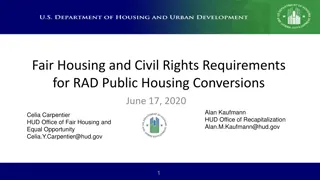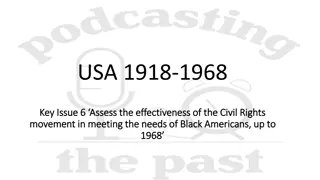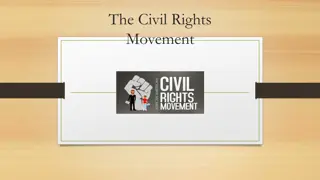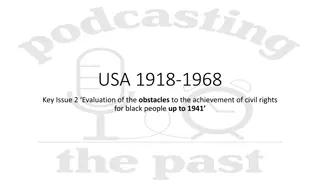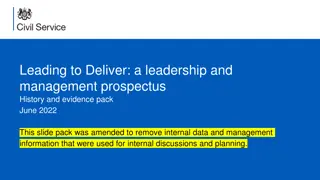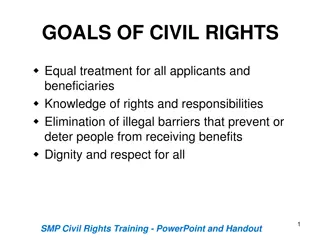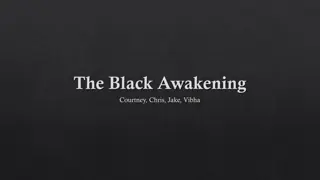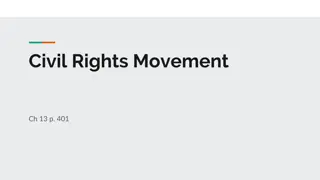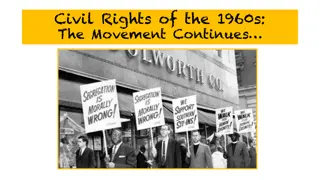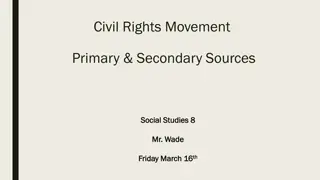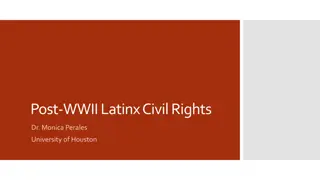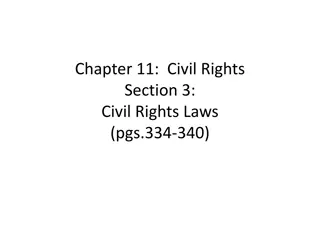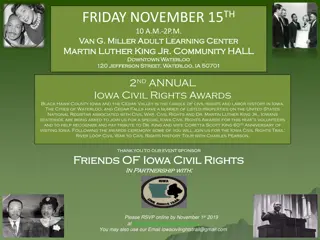Challenges and Evolution of the Civil Rights Movement
The Civil Rights Movement faced new challenges in the 1960s, with urban African Americans struggling with racism, economic disparities, and social issues. The Kerner Commission highlighted systemic racism, while incidents like the Watts Riot underscored ongoing tensions. The movement also saw a shift towards economic rights, as leaders like Martin Luther King Jr. grappled with the limitations of nonviolent protests, paving the way for the emergence of the Black Power movement.
Download Presentation

Please find below an Image/Link to download the presentation.
The content on the website is provided AS IS for your information and personal use only. It may not be sold, licensed, or shared on other websites without obtaining consent from the author.If you encounter any issues during the download, it is possible that the publisher has removed the file from their server.
You are allowed to download the files provided on this website for personal or commercial use, subject to the condition that they are used lawfully. All files are the property of their respective owners.
The content on the website is provided AS IS for your information and personal use only. It may not be sold, licensed, or shared on other websites without obtaining consent from the author.
E N D
Presentation Transcript
The Civil Rights Movement New Issues
Problems Facing Urban African Americans Civil Rights leaders had made great progress in the decade Civil Rights leaders had made great progress in the decade following the Montgomery bus boycott, but equality eluded following the Montgomery bus boycott, but equality eluded many African Americans many African Americans. Racism was still common in American society. In 1965, nearly 70 percent of African Americans lived cities. Many African Americans found themselves with low-paying jobs. Everyday problems were now economic and social.
Problems Facing Urban African Americans The Kerner Commission The Kerner Commission The Kerner Commission conducted a study of the problem. The commission blamed white society and white racism for the majority of the problems in the inner city. President Johnson s war on poverty addressed some of the same concerns for inner-city jobs and housing.
The Watts Riot Five days after the Voting Rights Act was passed: o A race riot broke out in Watts (an African American neighborhood in LA) Allegations of police brutality started the riot Lasted for 6 days Over 14,000 National Guardsmen and 1,500 law officers restored order $45 million in damage 900 injuries 34 people killed Riots in other cities broke out (Detroit was the worst) o It seemed that at any time and in any place, a riot could start
The Shift to Economic Rights By the mid By the mid- -1960s, a number of African American leaders were 1960s, a number of African American leaders were becoming critical of Martin Luther King s nonviolent becoming critical of Martin Luther King s nonviolent strategy strategy. Dr.King and his wife Coretta moved into an apartment in an African American neighborhood in Chicago. The Chicago Movement o made little headway, o Dr. King led a march through the all-white suburb of Cicero to demonstrate the need for open housing, he was met by angry white mobs similar to those in Birmingham.
Black Power Dr.King s failure in Chicago showed that non- violent protests could do little to change economic problems. Many young African Americans called for black power. To most, including Stokley Carmichael, the leader of SNCC in 1966, the term meant that African American Americans should control the social, political and economic direction of their struggle. Black power stressed pride in African Americans cultural group.
Black Power Malcolm X and the Nation of Islam Malcolm X and the Nation of Islam Malcolm X became a symbol of the black power movement. Prison transformed Malcolm Little (his original name). Went to the Muslim holy city of Makkah (also called Mecca) By 1964 Malcolm X had broken with the Black Muslims. He concluded that an integrated society was possible. He was shot and killed after criticizing the Nation of Islam s leader, Elijah Muhammad.
Black Power The Black Panthers The Black Panthers Malcolm X s ideas influenced a new generation of militant African American leaders who also preached black power. The Black Panthers believed that a revolution was necessary in the United States, and urged African Americans to arm themselves. Eldridge Cleaver, who served as the minister of culture, articulated many of the organization s objectives in his 1967 best-selling book, Soul on Ice.
The Assassination of Martin Luther King, Jr. In Memphis, Dr.King was assassinated by a sniper. In Memphis, Dr.King was assassinated by a sniper. Dr.King s death marked the end of an era in American History. The civil rights movement continued, but lacked the unity of purpose and vision that Dr. King had given it. Under his leadership, African Americans, many of whom were students, the civil rights movement transformed American Society.
Essay Question Describe three meanings that the term black power held Describe three meanings that the term black power held for African Americans. for African Americans.
Essay Question and Answer Describe three meanings that the term black power held Describe three meanings that the term black power held for African Americans. for African Americans. o A few African Americans interpreted balck power to mean that physical self-defense and even violence were acceptable in defense of one s freedom, which was a clear refection of Dr. King s philosophy. To most, the term meant that they should control the social, political, and economic direction of their struggle for equality. Black power also stressed pride in the African American cultural group. It emphasized racial distinctiveness instead of cultural assimilation. Pride in their racial heritage was manifested in new Afro hairstyles and African-style clothing, as well as the adoption of African names and a demand that African and African American Studies courses be adopted as part of the standard school curriculum.



